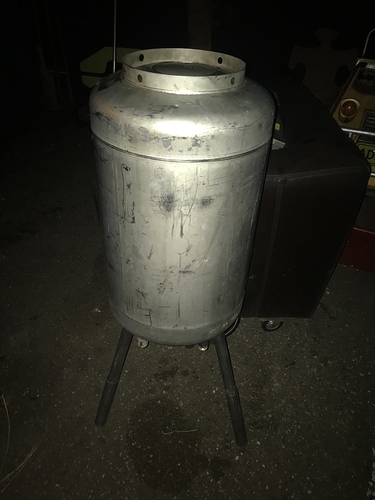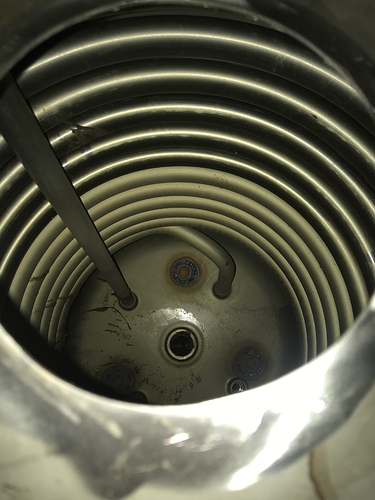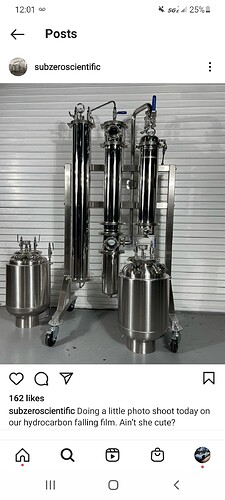Commas are so important
Every once in a while I get a good witty one in.
Absolutely not as fancy as the falling film
But defenatly a big improvement on recovery rates I got a hold of a used hot water boiler and cut a hole on top to fill dry ice in
Then used the 3/4” x 80 feet coil as condensor
Coils are often rated at 35 bar 500 psi Having gas come in on the long side end
And a T at the beginning with a small 1 1/2 “ triclamp tube as moisture catch flask
Keep the insulation jacket on makes a hell of a
Recovery coil
How does the moisture trap work?
All condensed water drizzles down the coil once it s at room temp after use
And falls into the cup
Fuck yeah! That’s some good shit Rogue!
I love it! You’re using it right off of the evaporator right?
Yes or as cooling power when running active in the corken 491
just want to bump this thread
Great thread!
Couple questions.
Where are you placing the desiccant? Before/above cold condenser?
Could you run this passive? How would accomplish that?
Could you use lc02 on the cold side? Would that steel handle the 100psi co2 pressure
Thanks and great thread
Subzero realesed a passive ffe hydrocarbon setup and seems to have a interesting setup. Could anyone elaborate?
Yeah you can run passive. Mol sieves would be prior to your condenser. Probably not above as you could risk solvent re condensing in the beads before it reaches the hits the condenser itself.
And you could run lc02 but you’d need thicker steel. 6mm. But probably not recommend for a tube n shell heat exchanger… people prefer Ln2 instead if used on the heat exchanger. Lc02 for a standard thicker steel column. But your best bet would be to get a chiller with the correct of amount of Kw to cool and enough kw to heat.
Incredible thread, just the sort of information I was looking for. Can anyone shed some light on the math to balance the heating cooling? How many kw of heating to how much cooling? Would it be equal in the ideal circumstances? How do we reference the math for this?
Without thinking too much on it I believe they should be close to equal but the cold side may be slightly smaller due to heat and pressure losses in plumbing between the two sides. You need to know not just how many units of power are “created” in your Heater and chiller but how many are actually transferred in your cold and hot heat exchangers. this can be done by evaluating the inlet and outlet conditions of one or both streams in your HEXs to calculate the energy gain or loss of that stream.
Ex:
Looking at the glycol stream of cold side HEX and measure inlet and outlet temps and the flow rates of glycol. Then;
Power (kW) transfered to hydrocarbon from glycol in Condenser HEX= mass flow rate glycol (kg/s) x specific heat of glycol(Cp = kJ/(kg x C or K) × inlet temp vs outlet temp of glycol (C or K) units work out to kJ/s or kW.
Assuming no loss of energy to surroundings (good approximation if HEX is insulated) then energy gained in glycol heating has been energy lost in butane cooling.
That’s all I got for now
3000 watts of heat and cooling for 1lb/ min recovery with nbutane
Start there, anything better then that is a bonus
Edit: watts not kilowatts
For the readers, is that 3000 watts heating and 3000 watts cooling? Or 1500 watts heating and 1500 watts cooling.
![]() please.
please.
3000 watts of heating and cooling.
using your ability to construct useful search queries.
eg: Search results for 'chiller math' - Future4200
note: you have to scroll to locate this classic: The ULTIMATE chiller calculator thread
I didn’t know what to search for my friend, this is why I asked specifically “how do we reference the math” and not “what is the math”. Thank you very much for that thread. I also assume - and this assumption could be off base - that the requirements and balance for a traditional jacket - tank or jacket - coil - tank system would be different from one where you’re attempting to continuously evaporate and recondense your solvent on the fly.


